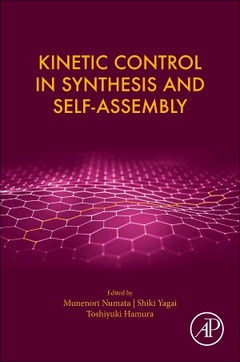Kinetic Control in Synthesis and Self-Assembly
Coordonnateurs : Numata Munenori, Yagai Shiki, Hamura Toshiyuki

Kinetic Control in Synthesis and Self-Assembly provides a unique overview of the fundamental principles, novel methods and practical applications for researchers across organic synthesis, supramolecular chemistry and materials sciences. The book examines naturally occurring molecular systems in which kinetic processes are more ubiquitous than thermodynamic processes, also exploring the control of reactions and molecular self-assemblies, through kinetic processes, in artificial systems. These methods currently play a crucial role for tuning materials functions. From organic synthesis, to supramolecular assemblies, and from restricted spaces, to material synthesis for hierarchical structures, the book offers valuable coverage for researchers across disciplines.
Interesting topics include how to regulate kinetic pathways more precisely, essential molecular design for kinetic traps, and how molecular environments surrounding molecules (i.e., solvent, temperature, and pressure effects) influence kinetic control in reactions and self-assemblies.
2. Kinetic structures in nature’s molecular systems
3. Kinetic control in organic synthesis
4. Kinetic control in supramolecular assemblies
5. Kinetic control in restricted space (such as flowing microspaces)
6. Kinetic traps for material synthesis; creation of hierarchical structures
Synthetic chemists and scientists in related areas such as materials science and chemical engineering
Shiki Yagai was born in 1975 in Yamanashi, Japan. He studied on self-aggregation of synthetic chlorophylls under the guidance of Prof. Hitoshi Tamiaki at Ritsumeikan University and received his PhD in 2002. Then he directly became an assistant professor of Chiba University, and became an associate professor in 2010. During 2006-2009, he pursued self-organized dye assemblies as a PRESTO researcher of Japan Science and Technology Agency. In July 2017, he became a full professor of the Institute for Global Prominent Research (IGPR), Chiba University. His research interests include supramolecular polymers, gels and liquid crystals of functional dyes and p-conjugated systems, photoresponsive molecular assemblies, organic solar cells and mechanochromic luminescence materials.
Toshiyuki Hamura was born in 1972 in Kanagawa, Japan. He studied new synthetic methods by using novel strained molecules under the guidance of Prof. Keisuke Suzuki at Keio University (1995–1998) and Tokyo Institute of Technology (1998–2000). Then he directly became an assistant profes
- Describes the nature and potential applications of kinetic processes compared to thermodynamic processes
- Presents information useful to researchers active in molecular synthesis and self-assembly toward materials
- Collates coverage of kinetic control for synthesis and self-assembly, treated separately in literature
Date de parution : 11-2018
Ouvrage de 324 p.
15x22.8 cm
Thèmes de Kinetic Control in Synthesis and Self-Assembly :
Mots-clés :
p Alignment; Aromatic compound; Aromatic compounds; Aryne; Asymmetric synthesis; Atomic force microscopy; Biodistribution; Bowl chirality; Bowl inversion; Buckybowl; Carbocycles; Cascade cyclization; Catalyst integration; Catalytic cyclization; Chiral auxiliary; Condensed aromatic compounds; Crystal growth from solution; Diffusion; DNA origami; DNA scaffold; DNA-binding protein; Domino reaction; Dynamic kinetic resolution; Femtosecond laser irradiation; Glycoclusters; Glycosylated proteins; Halogen–lithium exchange; Helical structure; Heteroatom effect; Higher-order structure; Hydrogenation; Hydrolase; Immunosuppressive activity; In vivo metal complexes; Isobenzofuran; Kinetic control; Kinetic resolution; Lipase; Mesoporous silica; Metal-organic frameworks; Metastable phase; Metastable state; Microflow; Nanopores; N-glycans; Nonequilibrium process; Palau'amine; Pathway complexity; Pharmaceutical compounds; Photoisomerization; Polyacene; Polycyclic ring core; Polymer blend; Polymer; Polymer-induced heteronucleation; Polymerization; Polymorphic control; Protein–DNA conjugation methods; Proton relay; Reaction equilibrium; Reaction integration; Ring selectivity; Ruthenium; Self-assembly; Self-ligating protein tag; Sequence-selective covalent bond formation; Sequential enzyme reactions; Single bond; Singlet diradical; Small HOMO–LUMO gaps; Stable phase; Steric repulsion; Stretch effect; Substituent effect; Successive cycloaddition; Supramolecular assembly; Supramolecular polymer; Supramolecular polymers; Template; Time-dependent evolution; Topology; Toroidal structure; Total synthesis of natural products; Total synthesis; Transition metal catalyst; Ultrasonic irradiation; Vanadium



